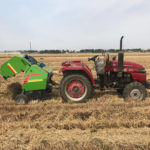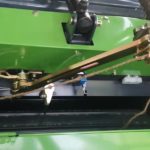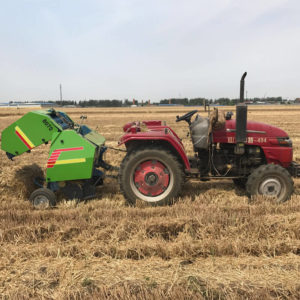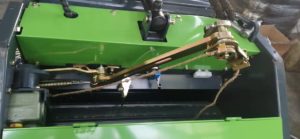Baler refers to a machine used to bale grass. It has the following characteristics:
- It has a wide range of applications. It can be used for picking up and bundling natural grass such as straw, wheat straw, cotton stalk, corn stalk, rape stalk, peanut vine, beanstalk, alfalfa, flax, etc.;
- There are many supporting functions, which can be directly picked up and bundled, or cut first and then picked up and bundled, or crushed and then bundled;
- High work efficiency.
Classification
Divided into hydraulic tying machine and tractor-trailer tying machine;
From the perspective of raw materials, it is divided into corn stalk balers, wheat straw balers, straw balers, flax balers, etc.;
From the shape of the finished product: square bale baler, round bale baler.
Develop
In the 18th century, transportation and agricultural production in many countries were powered by horses. In this way, large amounts of hay were needed to raise horses in vast cities and rural areas. When transporting this hay, the grass had to be compacted and bundled. In 1853, Emory in the United States invented a straw baler to make the bale strong and easy to transport. This kind of baler is a horizontal press. Each extension part of the baler box is equipped with a baffle that functions as a piston. When the grass is placed in the box, a set of chain and pulley mechanisms is pulled by Malay In this way, the baffles at both ends of the baling box move towards each other to compress the grass. This kind of baler can bale 5 bales per hour, and each bale weighs 125 kilograms. Its disadvantage is that when the machine is running, it still requires workers to do auxiliary work.
In 1872, Charles Withington of the United States developed a continuous production strapping machine, which achieved great success in the United States and the United Kingdom, thus speeding up the pace of production.
Due to the need to continuously improve production capacity, in 1884, a steam pressure bundling machine was developed. After the baler presses the grass into a bale, the user bales the bale, and then automatically ejects the bale.
In 1871, American Walter Wood obtained a patent for a wire tying machine. At that time, this kind of tying machine was excellent, and it was exhibited in the UK.
In 1858, John Fei Appleby invented the rope tying machine, but due to the high price of the rope, this technology was not developed until 20 years later. This kind of tying machine is easy to use and has a smart model. In 1878, the tying machine produced by the manufacturer Dilling adopted Appleby’s tying method.
Before 1958, the balers could only fold the wheat bales into a rectangular shape. In 1958, the American Ellis Chalmers Company put the cylindrical balers developed by Roto Baller into commercial production. Bundle wheat stalks into cylinders with a diameter of 36-56 cm, a length of 0.91 m, and a bundle of 18-45 kg. This kind of baler is still in use in some places.
Operation and maintenance
- According to the choice of two picking widths, it is suitable for different picking widths and has super strength.
- The compression mechanism assembly is located on the upper part of the pickup mechanism assembly, the same picking range, the equipment width is smaller, and it is more convenient for small field operations. The overall layout is more reasonable.
- Technical features: adopting four-wheel tractor for positive traction operation, stable operation, convenient for matching and promotion.
- The power input is equipped with a safety clutch, and the main drive shaft, compression device, and rope binding device are equipped with safety bolts. When the system load is too large, the bolts are automatically cut to cut off the power transmission of the tractor and protect the system from damage.
- The knotter imported from Germany is adopted, which can adapt to the bundling operation of different biological materials, is firm and reliable, and can adjust the length of different bales, which is efficient and flexible.
- Automatically pick up straw and weeds, automatically separate mud and sand, automatically feed materials, automatically compress, automatically tie ropes, and automatically unpack. The whole process is fully automatic, easy to operate, and highly efficient. There are profiling wheels on both sides of the picker, so that the picker can maintain a proper distance from the ground and has good profiling performance. The spring teeth on the upper end of each rack of the picker are slightly tilted up, which is convenient for picking up the straw, and it can automatically avoid the hard objects such as rocks.
Features
- Compared with the historical hydraulic strapping machine, it has simple structure, reliable performance, easy operation and maintenance, good usability and low maintenance cost.
- There are no hydraulic drills, hydraulic valves, accumulators and other components necessary for hydraulic balers, and there is no temperature raising and lowering device for stable changes in the hydraulic system. The energy-saving effect is obvious. Compared with most balers used in the past, it saves 5KW per hour on average in energy consumption compared with similar products, and can save more than 40,000 yuan in electricity bills annually.
- There is no hydraulic oil running, leaking, or leakage, which is beneficial to environmental protection.
- Easy to install, just need to make the roller table, you can use it immediately, no need to debug. Vertical waist beating, waist buckle on top, steel bundle on top, steel bundle on the roller table, the steel bundle does not scrape the side bladder of the roller groove when it moves on the roller table.
- The operation is simple, remote operation is realized, without additional labor, and can be performed synchronously in the control room without training.
- Low power, pure machinery, no pollution, in line with the national industrial policy of environmental protection and low carbon.






